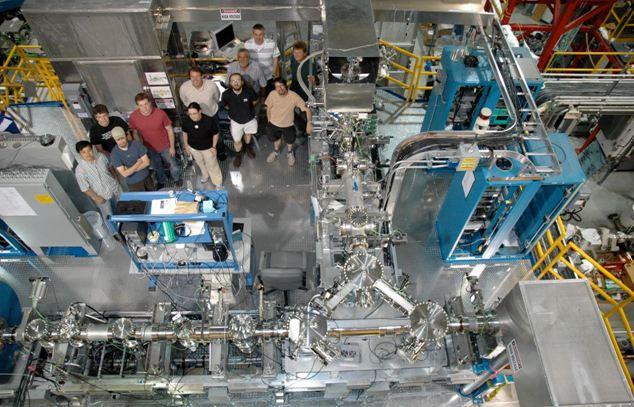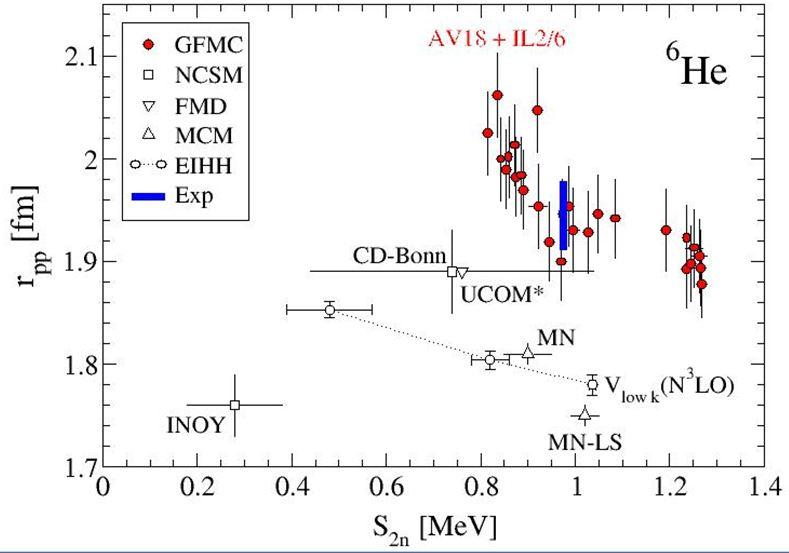First direct mass measurements of the exotic helium isotopes and precision calculations for understanding the nuclear interactionNeutron-rich light nuclei exhibit fascinating phenomena like the formation of a halo structure of loosely-bound neutrons surrounding a tightly bound core, similar to electrons in atoms. He-6 is the lightest of them and is called a borromean system, because all the three possible two-body subsystems (two-neutron and neutron-core) are unbound, but the three-body system is bound. The name borromean comes from an analogy to the borromean rings, where three rings are interlaced so that they stay together only if all three, but fall apart if just one of them is removed. A neat implementation of the proverb "united we stand, divided we fall." Such rings were historically the emblem of the Borromeo family in Italy in the fifteenth century and symbolized a strong union. |  |
Recently the first direct mass-measurement of the two-neutron halo nucleus He-6 was carried out at TRIUMF together with a more precise measurement of the value for the four-neutron halo He-8 mass. Measurements where performed using the TITAN Penning trap mass spectrometer. TITAN is currently the only system in the world where such measurements can be performed, due to its rapid measurement capabilities while preserving the required precision. The resulting new masses lead to improved values of the charge radii and the two-neutron separation energies, which combined provide stringent tests for three-body forces at neutron-rich extremes. State-of-the-art ab-initio calculations for He-6 performed at TRIUMF were published together with the new experimental data in a new Physical Review Letter (see URL: http://prl.aps.org/abstract/PRL/v108/i5/e052504). This article was also highlighted as an Editor's Selection in the prestigious journal. Following the TITAN measurements, the new He-6 two-neutron separation energy is 975.46(23) keV. The He-6 charge radius was newly evaluated using the isotopic shift measurements performed at the Argonne National Laboratory, together with the new TITAN mass value. The He-6 TITAN mass improves the precision of the charge radius by 23%, leading to 2.060(8) fm. |  |
In the second figure, we compare the point-proton radius and the two-neutron separation energy of He-6 to ab-initio calculations based on different nucleon-nucleon and three-nucleon interactions. The new calculations performed at TRIUMF were obtained with the Effective Interaction Hyperspherical Harmonics (EIHH) method using chiral low-momentum nucleon-nucleon interactions. This is part of an ongoing effort to utilizing chiral effective field theory to predict the properties of halo nuclei. The obtained energies and radii are converged within the calculational uncertainty given by the error bars. The three points, obtain from different phase-shift-equivalent two-body forces, lie on a line which points towards a corrleation of these observables. Such a correlation line lies below the experimental band, though. All other previous ab-intio calculation obtained with two-body forces only (not based on effective field theory) lie below the experiment. The Green's Function Monte Carlo (GFMC) results are the only calculations that include three-nucleon forces. The scatter of the points is a measure of the uncertainty in the phenomenological three-nucleon force model and in the numerical method. Because in GFMC three-nucleon forces are constrained to reproduce the properties of light nuclei, including He-6, they cannot be considered pure predictions. Nevertheless, the comparison to theory clearly demonstrates the importance of including and advancing three-nucleon forces.
Efforts to include three-nucleon forces from effective field theory in the EIHH calculation are being taken and it will be interesting to see if this will reconcile theory with experiment. TRIUMF theorists and experimentalist can say: united we stand, or better, united we understand.
-- by Sonia Bacca, TRIUMF scientist
